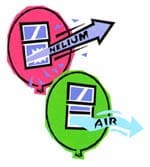Learning About Permeability
Experiment #2
In this activity, the children investigate two properties of latex balloons — they stretch and they are “permeable,” that is gases such as air and helium can pass slowly through the latex membrane.
Getting Started:
You can discuss gases in the atmosphere, composition of gases, atoms and molecules. Inflating a balloon and sticking a long, thin wire, which can obtained at a flower shop, through the balloon without bursting it can raise questions about the composition of natural products and molecules. Inflating the balloons can be accomplished safely with an inexpensive hand inflator sold for about $5 at gift and card shops.
Collecting Data:
Balloons Stretch.
Children can work in pairs. One will inflate the balloon, the other will measure the circumference with string. The length of the string that fits snugly around the balloon is the circumference. Children can measure the length on a yardstick or meter stick.
The teams can inflate their balloons until they burst. Have each team record the length of the circumference when its balloon bursts. Were the bursting circumferences all alike? If not, ask the children to discuss why they think some burst at a smaller size than others.
Balloons Leak.
You can start this activity by blowing up a balloon until it is well -inflated. Close it by tying a knot in the neck or by tying it tightly with string. Show the balloon to the class and ask whether the balloon will stay this size. There will probably be a difference of opinion. Tell them that they can find out whether the balloon will stay this size. There will probably be a difference of opinion. Tell them that they can find out whether or not inflated balloons stay the same size by measuring the circumferences with string as they did in the earlier experiment.
Give small groups of children balloons and have them inflate them, tie them off and measure and record the circumferences. Have them make measurements several times during the first day and then daily until the balloons have deflated significantly as, “Where did the air go?” You can tell the children that even thought they cannot see holes in the balloon, there are very, very tiny ones that let the air escape.
balloons have deflated significantly as, “Where did the air go?” You can tell the children that even thought they cannot see holes in the balloon, there are very, very tiny ones that let the air escape.
Next, use helium to compare the difference between the two gases. Have the students compare the rate of escape of helium from balloons with the rate of escape of air. Be sure to use the same kind of balloons, inflated to the same size (circumference.) Measure the circumference at intervals as the balloons get smaller and record the time and circumference.
Since obtaining a helium tank can be expensive, most card and gift shops will inflate balloons with helium for a few dollars. You can bring pre-inflated balloons to class to conduct the experiment.
Charting Results:
The children probably will find that the helium-filled balloons get smaller faster than the air-filled ones. Ask them to write about their observations and explain why this happens. The explanation is that particles (atoms) of helium are smaller than the particles (molecules of oxygen and nitrogen) of air and so can pass through the very tiny holes in the rubber more easily.